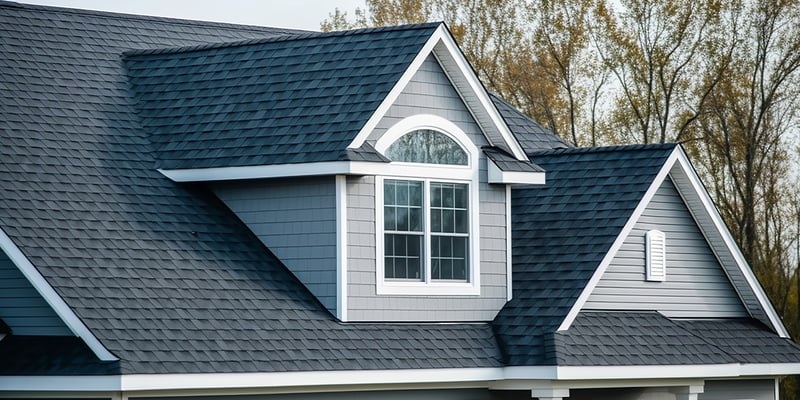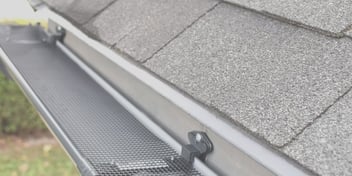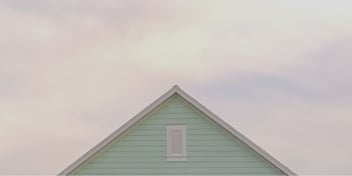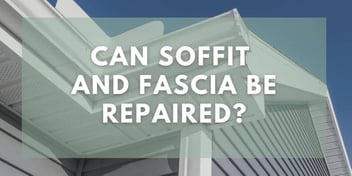- Home »
- Learningcenter »
- Roof rakes vs eaves
Roof Rakes vs Eaves: What Are These And How Do They Work?

You might not hear about your roof rakes or eaves very often, but they are an important part of your roof protection and appearance. They help protect your home from harsh weather and they contribute to your home's curb appeal. It goes without saying - those two things are a big deal!
I'm here to share some important tips on how to look after them. Stay with me, and you'll pick up some helpful advice that could prevent some major troubles down the line!
The Parts and Types of Roof Eaves
Roof eaves might not catch your eye until something goes wrong. They add important parts like the fascia, soffit, flashing, and vents, which all help keep your roof safe and breathable, which is really important!
The fascia is the board along the roof's edge. It connects to rafters or trusses, supports roofing parts, and has a cool appearance. It also holds your gutters, which are super really important for managing rainwater. Without strong fascia, your roof wouldn't look as good or support gutters nearly as well.
Then there's the soffit, neatly tucked under the fascia, filling the space between your roof edge and the wall. It's pretty hard to see unless you're looking up from below, you know? Soffits are usually made from vinyl, wood, or aluminum, keeping pests out and protecting your home against rough weather. They're really important for protecting your home. Some soffits even add vents to let air flow into your attic, which helps a lot in protecting against dampness and extreme temperatures, and this will ensure your comfort while maintaining your roof's structure.

Flashing really plays a big part that might often go unnoticed, and it's usually made out of metal. It directs water away from where your roof meets the walls, and it's always working hard to prevent leaks and moisture damage! What I find really interesting is how something so easy is so important in keeping our homes dry and comfy. This thing is always battling against the features to keep us safe and dry inside, which is something we often take for granted!
And introducing the vents that are part of your eaves. They're super really important for maintaining a balanced attic climate and encouraging air circulation. This helps a lot in controlling moisture and temperature, which is great because it prevents mold and wood rot.
So, are you keeping an eye on your roof eaves? I've found that each part plays an important part, which will make sure your roof stays in great shape!
Remember: the right ventilation in your attic can really go a long way to extend your roof's lifespan!
What Are Roof Rakes?
Roof rakes play an important part in keeping your home safe and looking good! On the one hand, the rake part of a roof refers to the sloped edges that run along the sides of a gabled roof. These edges help keep water, snow, and debris from sneaking under your shingles, which keeps your roof sturdy and your house looking cool.
Have you seen those rake edges that are sometimes left out in the open or all bundled up and closed off? When the rakes are open, you can actually see the wood framing hiding underneath. This design usually works really well with simple and cozy homes, like your classic cottage, and adds a little bit of rustic beauty.
On the other hand, there are those closed rakes that are all wrapped up and carefully dressed in things like drip edges. These are great because they come with some extra protection against badly intrusive features. This setup is actually pretty cool as it covers your roof from dampness and difficult pests, really stepping up your home's defense game.
Also, from my experience, it usually gives your home a tidier, more "put together" look. And honestly, that's a good thing if you're all about keeping things smart and clean!

Now, let's switch over to talking about roof rakes as a tool, shall we? They're important for maintaining your roof, especially in places where it snows a lot. These rakes have a flat blade attached to a pole that you can extend, and they let you pull snow from your roof without having to climb up there. This helps prevent problems like ice dams and too much weight on your roof, which could cause damage.
I think it's important to choose the right kind of roof rake, depending on what you need it for. Some rakes are great for cleaning out gutters, while others might have a long reach to handle different kinds of debris. No matter the type, a roof rake is a big part of keeping your home safe, and it can save you a lot of hassle when it snows.
Both types of roof rakes - if part of the structure or as a maintenance tool - are important in creating your roof that lasts longer and keeps looking its best, which makes your home safer and more comfortable to live in!
Every year, over 500,000 homes in snowy regions benefit from roof rakes regularly. It's definitely worth it when you think about it if you live in one of these areas!
Difference Between Drip Edge, Rake Edge, and Fascia
If you're just getting into roofing, terms like "drip edge," "rake edge," and "fascia" might sound a bit complicated, but let me help you understand these to better protect your home!
A drip edge is this helpful piece of metal that gently guides water away from your roof's fascia and other important underlying parts. Have you ever seen water pouring down the side of your house during a storm or seen some nasty water damage at your roof's edge? Well, a drip edge was built to stop exactly that!
It's usually made from parts like aluminum, galvanized baseball, or copper and comes in a few different shapes - like the L-shaped Type C, T-shaped Type D, and Type F (also known as the gutter apron). Each type was built to handle specific types of water runoff.

Next, we have the rake edge- the sloping side of your gabled roof, which runs all the way from the bottom of the eave up to the ridge at the top. Rake edges can either be open or closed and use flashings similar to drip edges, but they specifically protect the rake frieze boards from water trying to sneak in. Plus, keeping out pests and rot, these edges also help prevent ice dams from creating. Basically, the rake edge acts as an important barrier, defending your home from all sorts of environmental challenges.
Then, there's the fascia, which is this horizontal board that runs along the roof edge, covering up the ends of the roof rafters and is usually visible from the street, giving your roofline a cool, finished appearance. But I'm talking about looks - the fascia supports the lower edge of the roof and gives a great place to mount gutters. It improves your home's curb appeal and also plays an important part in protecting the roof's edge from water damage.
Every part is really important for maintaining the overall strength and functionality of your roof - choose wisely to keep your roof in top shape.
How Do Eaves and Rakes Protect Your Home?
Eaves and rakes are really important parts of your home, helping to keep it safe and looking good, yet they often don't get much attention! Eaves stick out past your walls to keep rainwater away from your foundation, which stops erosion and protects your home's structure. They also shade your rooms, which lessens sunlight exposure and helps keep your house cooler, lowering your energy bills. Eaves with vented soffits help with attic ventilation, letting in fresh air, which prevents moisture build-up and mold growth, helping your roof last longer. Besides, the overhang keeps pests like birds and rodents from getting into your roof or attic.
Eaves serve a practical job and also help with your home's look, adding a bit to its curb appeal and matching your home's overall style. But, it's important to clean and check your eaves regularly to catch any damage early.
Roof rakes play a similar part in managing water runoff - they form the angled edge of your roof that channels water right to the eaves, reducing the risk of leaks and mold. Their tight seal keeps pests and debris out, helping to keep the structure of your attic and walls solid.

You know, I've found that just like checking eaves, if we take a little time to make it a habit to look over our roof rakes, it can really help us spot and deal with issues like cracks or rot early on. This easy action can save us from running into bigger, more troublesome issues later on. So why not give it a try?
So, have you checked your roof's eaves and rakes lately? It's really a good idea to give them a little look every now and then. Just think, a quick check here and there can keep your place looking good and staying strong! Remember, keeping an eye on these parts can save you from a lot of hassle and unexpected repairs down the line. Why not make it part of your home maintenance schedule? It could really make a difference!
How Do Eaves and Rakes Look Aesthetically?
Eaves and rakes are really important for a building's aesthetics and also its functionality, too. Whether you're thinking about housekeeping or making some updates to the exterior of your home, it's really important to understand the different styles available and what they can bring to your home's overall look.
Take boxed eaves, to give you an example, which you might spot on in Colonial, Greek Revival, and Classical Revival homes. These usually add complete trim and molding, lending a formal appearance.
On the other hand, open eaves are pretty common in Craftsman homes, where they display the rafters and give off a more natural, simple tone.
If a more polished appearance is loved by you, then the closed eaves found in Gothic Revival and Tudor homes might be right up your alley, often adorned with cool decorative features like brackets or dental molding.

Rakes play an equally important part because they help to define the gable end of your roof and extend the stylistic features started by the eaves. They can also add nice touches like corbels or delicate trim, which really make the architectural design pop and heighten your home's curb appeal! The way rakes and eaves work together can dramatically change the overall appearance of your roof. It's worth checking out the different types of rakes, too.
Overhanging rakes, to give you an example, which protrude beyond the gable end, are excellent for protecting the building, and are a favorite in more traditional architectural styles.
On the flip side, flat rakes present a clean, modern look that syncs beautifully with a minimalist style.
When the overhangs of your eaves and rakes match, it can really help with the appearance of your home. Also, picking a good choice of parts and colors, like wood, vinyl, or aluminum, is important. These choices can either complement the overall aesthetic of your home or stand out as special features in their own right.
If you're attracted to the delicate details typical of classical styles like Greek Revival or Colonial, which often have classic ornamental cornices and friezes, or you like the simplistic appeal of modern minimalist designs that stress straight lines and minimal trim, understanding these features can really help you make the best decisions for your home's exterior.
A carefully chosen eave or rake can really turn the look of your home's exterior - so never underestimate their importance!
Protect The Roof Over Your Head
When was the last time you checked these areas on your roof? If you forget them, it can lead to some more expensive fixes down the road. It's really important to stay on top of this to keep your home safe, comfy, and energy-efficient all year round. You might think eaves and rakes seem simple, but they actually make a big difference.

Here at Colony Roofers, we completely understand how important every part of your roof is. We have roofing services in Georgia, Florida, and Texas for homes and businesses. Keeping your rooftop is a good idea to protect your home and safety.
Why not try to give us a call for a free inspection? You'll get to see our team's professionalism and dedication firsthand. We're here at Colony Roofers to bring you excellent service and results. Contact us today, and let's start taking care of your roof.
 Call (678) 365-3138
Call (678) 365-3138



